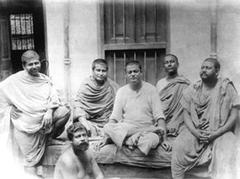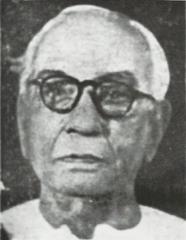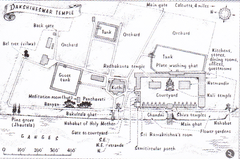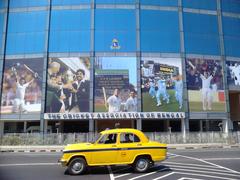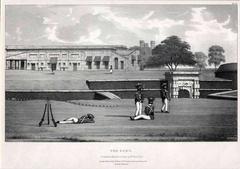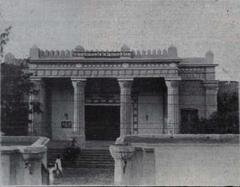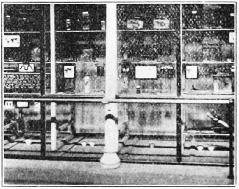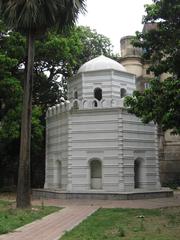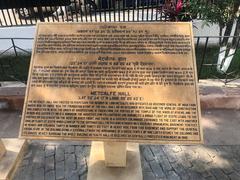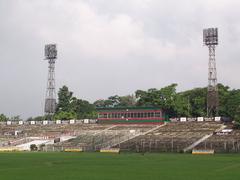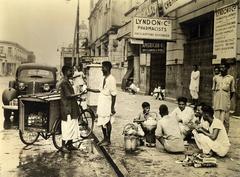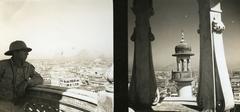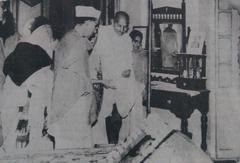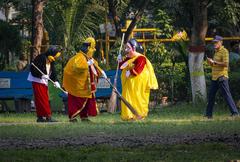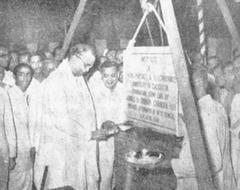Esplanade Mansions Kolkata: Visiting Hours, Tickets, and Historical Site Guide
Date: 14/06/2025
Introduction
Esplanade Mansions stands as an architectural and historical jewel in the heart of Kolkata’s bustling Esplanade district. Erected in 1910 by David Elias Ezra, a leading Jewish businessman of his time, the building is not only Kolkata’s sole example of Art Nouveau architecture but also a witness to the city’s transformation from the colonial capital of British India to a modern metropolis (Curly Tales; Calcutta Chronicle). Its distinctive façade, adorned with intricate ornamentation, has become a visual symbol of Kolkata’s layered history and cosmopolitan spirit.
This guide provides a detailed exploration of Esplanade Mansions’ origins, architectural features, historical roles, and practical information for visitors, alongside travel tips and recommendations for nearby attractions.
Historical and Architectural Significance
Origins and Construction
Esplanade Mansions was constructed in 1910 on a site previously occupied by Scott Thompson’s shop and two houses, reflecting the city’s rapid urban expansion in the early 20th century. Commissioned by David Elias Ezra, who played a significant role in shaping Kolkata’s urban landscape, the structure was designed by Martin & Co., a prominent contractor of the era (Wikipedia; Tutorial at Home). Ezra’s contributions extend to other city landmarks such as Chowringhee Mansions and Ezra Mansions (Calcutta Chronicle).
Unique Art Nouveau Features
Esplanade Mansions is celebrated as the only surviving Art Nouveau structure in Kolkata. Its façade features ornate carvings, circular balconies, decorative columns, and arched windows, all blending organic motifs with Edwardian influences (Evendo). The corner tower and cupola distinguish its silhouette, contributing to the city’s eclectic skyline (Calcutta Chronicle). Designed with 24 spacious flats, the building was initially intended for affluent families seeking both comfort and status (BBC).
Colonial and Wartime Legacy
Situated opposite the Raj Bhavan, Esplanade Mansions was at the epicenter of colonial administration. During World War II, the building was requisitioned by the American government, serving both as accommodation for soldiers and as the American Library (Inditales). This role underscores the building’s adaptability and its significance during crucial periods of Kolkata’s history.
Post-Independence Transformation
After independence, Kolkata’s role as the nation’s capital waned, but its heritage structures remained integral to the city’s identity. Esplanade Mansions became a mixed-use property under the ownership of the Life Insurance Corporation of India (LIC), housing government offices such as the Eastern Railways’ Chief Public Relations Officer, the Railway Claims Tribunal, and some residential flats (Curly Tales; Calcutta Chronicle).
Heritage Status and Preservation
Recognized as a Grade-I heritage structure by the Kolkata Municipal Corporation, Esplanade Mansions is legally protected, ensuring its preservation amid the pressures of urban development (Wikipedia; BBC). Restoration projects have revived its white façade and intricate detailing, serving as a model for heritage conservation efforts in the city (Tutorial at Home).
Visitor Information
Visiting Hours and Admission
Esplanade Mansions currently functions as an office and residential building. There is no formal entry fee or ticketing system, and internal access is restricted to authorized personnel or those with official appointments. The building’s exterior and immediate vicinity can be viewed freely between 9:00 AM and 6:00 PM. Occasionally, heritage walks organized by local groups may include the site’s exterior in their itinerary—advance booking for such tours is recommended.
Accessibility and Getting There
- Metro: The nearest station is Esplanade Metro Station (Line 1), a 5-minute walk away.
- Bus/Tram: Multiple city routes and tram lines serve the Esplanade area.
- Taxi/Auto-rickshaw: Cabs and auto-rickshaws are readily available; mention Esplanade Mansions or Raj Bhavan for easy navigation.
The building’s exterior is accessible from public sidewalks. Due to ongoing office use, wheelchair access to interior spaces is limited, but public areas around the building are generally navigable.
Nearby Attractions
Enhance your visit by exploring these nearby sites:
- Raj Bhavan: The Governor’s residence, directly opposite Esplanade Mansions.
- Victoria Memorial: A grand marble monument and museum.
- Indian Museum: The country’s oldest and largest museum.
- Metropolitan Building: Another colonial-era landmark.
- Curzon Park, Shaheed Minar, Town Hall, Eden Gardens, New Market: All within walking distance.
Tips for Visitors
- Best Time: Visit during early morning or late afternoon for optimal lighting and cooler temperatures.
- Guided Tours: Book heritage walks for a deeper historical context.
- Photography: The façade is highly photogenic; use discretion and avoid professional equipment without prior permission.
- Safety: The area is safe during the day, but exercise caution in crowded spaces.
Preservation and Community Involvement
Esplanade Mansions’ Grade-I heritage status ensures ongoing protection, with restoration managed by LIC and municipal authorities (Trek Zone). Local heritage groups advocate for its conservation, and travelers can support these efforts by participating in heritage walks and spreading awareness.
Frequently Asked Questions (FAQs)
Q: Can I enter Esplanade Mansions as a tourist?
A: No, internal access is restricted. The building is in use for offices and some residences.
Q: Are guided tours available?
A: There are no formal tours inside the building, but its exterior is featured in several heritage walks.
Q: Is there an entry fee?
A: No fee is required to view the building from public areas.
Q: What are some nearby attractions?
A: Raj Bhavan, Victoria Memorial, Indian Museum, New Market, and more.
Q: Is the area accessible by public transport?
A: Yes, via metro, bus, tram, and taxis.
Summary and Recommendations
Esplanade Mansions is a living testament to Kolkata’s colonial grandeur, unique Art Nouveau design, and enduring historical significance (Calcutta Chronicle; Curly Tales). While interior access is limited, its façade continues to inspire admiration. Combine your visit with other nearby landmarks for a comprehensive heritage experience.
For a self-guided exploration, use mobile apps like Audiala for curated heritage walks, maps, and updates. Support Kolkata’s preservation efforts by respecting guidelines and participating in responsible tourism.
References
- Curly Tales - Dating Back To 1910, Esplanade Mansions On Esplanade Where Kolkatans Love To Shop Is A Preserved Slice Of History
- Calcutta Chronicle - Esplanade Mansions: The Grand Palace Of The City
- Wikipedia - Esplanade Mansions, Kolkata
- BBC - The Disappearing Mansions Of Kolkata
- Inditales - Kolkata Colonial Calcutta Heritage Walk
- Tutorial at Home - Heritage Commercial Buildings: Esplanade Mansion
- Trek Zone - Esplanade Mansions Kolkata
- Evendo - Esplanade Mansions
- Wikivoyage - Kolkata/Esplanade
- LBB - Esplanade in Kolkata
- Grrrltraveler - Kolkata Travel Guide
- Yometro - Best Places to Visit in June in Kolkata
- Holidify - Kolkata Sightseeing Guide
- Audiala app
